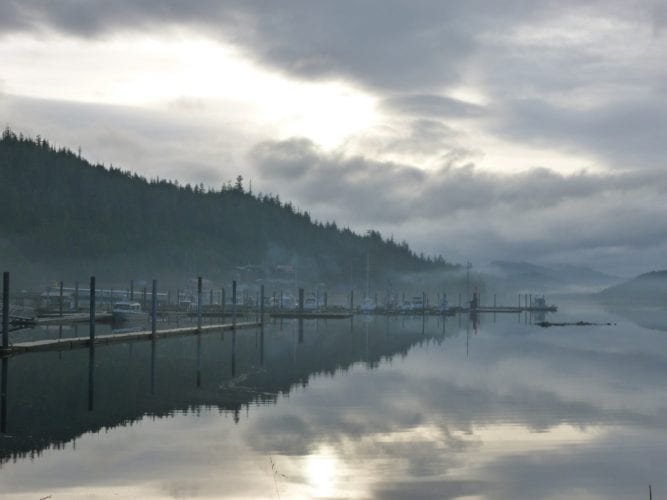
The harbor at Thorne Bay on Prince of Wales Island. Photo Credit: Department of Commerce, Community and Economic Development; Division of Community and Regional Affairs’ Community Photo Library
A large timber sale on the Tongass National Forest is not as large as it was advertised. An environmental watchdog organization has uncovered a U.S. Forest Service document showing a 12-million-board-foot mistake on the Big Thorne timber sale on Prince of Wales Island in Southeast Alaska. The U.S. Forest Service wants to settle the error with the Viking Lumber Company of Klawock, which was awarded the contract for harvesting the timber in 2014.
Audio PlayerPublic Employees for Environmental Responsibility, or PEER, based in Silver Spring, Maryland, has published Forest Service documents on its website detailing a review of timber sale contracts on the Tongass National Forest. This spring, PEER highlighted a Forest Service review that found errors in procedures, oversight and contract enforcement. Other documents from Regional Forester Beth Pendleton directed staff to fix an error in calculating the cost of hauling timber cut under the Big Thorne contract, but then rescinded that direction.
Jeff Ruch, PEER’s executive director, characterizes another document written by Acting Regional Forester Rebecca Nourse like this: “One of the most extraordinary memos we’ve ever seen to the chief of the Forest Service basically demanding that he authorize additional retroactive payments immediately even though there’s in the terms of the memo no contract mechanism, meaning it’s not provided for under the contract, it’s not owed to them and in a situation where the company wouldn’t even file a formal claim,” Ruch said. “So it’s a hell of a way to run a railroad ‘cause everyone thinks you guys up there on the Tongass are growing cedar and spruce but it looks like you’re growing money.”
In that memo, Nourse writes that a review of Big Thorne timber contract found the agency over-represented the amount of timber actually sold by 12 million board feet. “The independent review shows unexplained departures from policy, which puts the Forest Service at risk of significant damages should the purchaser pursue a claim.” The memo says the agency should seek to negotiate a settlement instead. It proposes several options: taking no action and expecting a claim from Viking, or cancelling the contract and re-offering the timber sale at a later date. That could also result in a claim from the company. Nourse’s preferred option is to modify the contract and change the rates charged to Viking.
That company was awarded the contract in 2014 and has been logging the timber on National Forest land around Thorne Bay on eastern Prince of Wales Island. The contract at the time was for a harvest of 97 million board feet of timber valued at more than 6.5 million dollars. As of the beginning of this year, the Forest Service said the company still had a little more than a third of that left to cut. PEER’s Ruch calls for an in-depth audit of the sale contract.
“So you would think given all of the confusion here they would bring in some outside people to basically go over the books to find out what’s going and that’s not the case,” Ruch said. “It’s sort of like the Region 10, the Alaska people of the Forest Service, are in flagrant violation of what we know as the rule of holes, which is when you’re in one, stop digging.”
The organization has also requested other documents under the Freedom of Information Act and subsequently filed a lawsuit in U.S. District Court in Washington, D.C., seeking to get more information on the agency’s review of Tongass timber sales. The lawsuit says, “PEER has reason to believe that (sic) Forest Service was either actively engaging or complicit in the unlawful sale of high-value timber at prices far below market value.”
A call for comment from Viking Lumber was not returned.
Alaska Forest Association executive director Owen Graham says the industry group is not surprised to hear of less timber in that contract. He did not trust the amount of timber that the sale supposedly contained in units to be logged by helicopter. “The helicopter volume per acre that they were projecting for a partial cut was just triple what we’d experienced in the past,” Graham said. “We were always questioning whether that was, we didn’t believe it was there.”
Graham said there were other problems with the Forest Service’s timber cruise, or assessment of the quality, size and types of trees in various harvest units. He thinks it makes sense for the agency to negotiate with the company to fix the mistake.
“You know, resolving issues on contracts is pretty common in all the industries, but particularly the timber industry,” Graham said. “You sit down and work it out. Everybody’s interested in long-term relationships, not just cash in your hand today or something.”
Graham thinks the other options would mean that sawmill runs out of wood and could be forced to shut down. The Forest Service did not respond to a request for comment Monday or Tuesday. An official previously said the agency would not discuss Big Thorne, because of PEER’s complaints.










